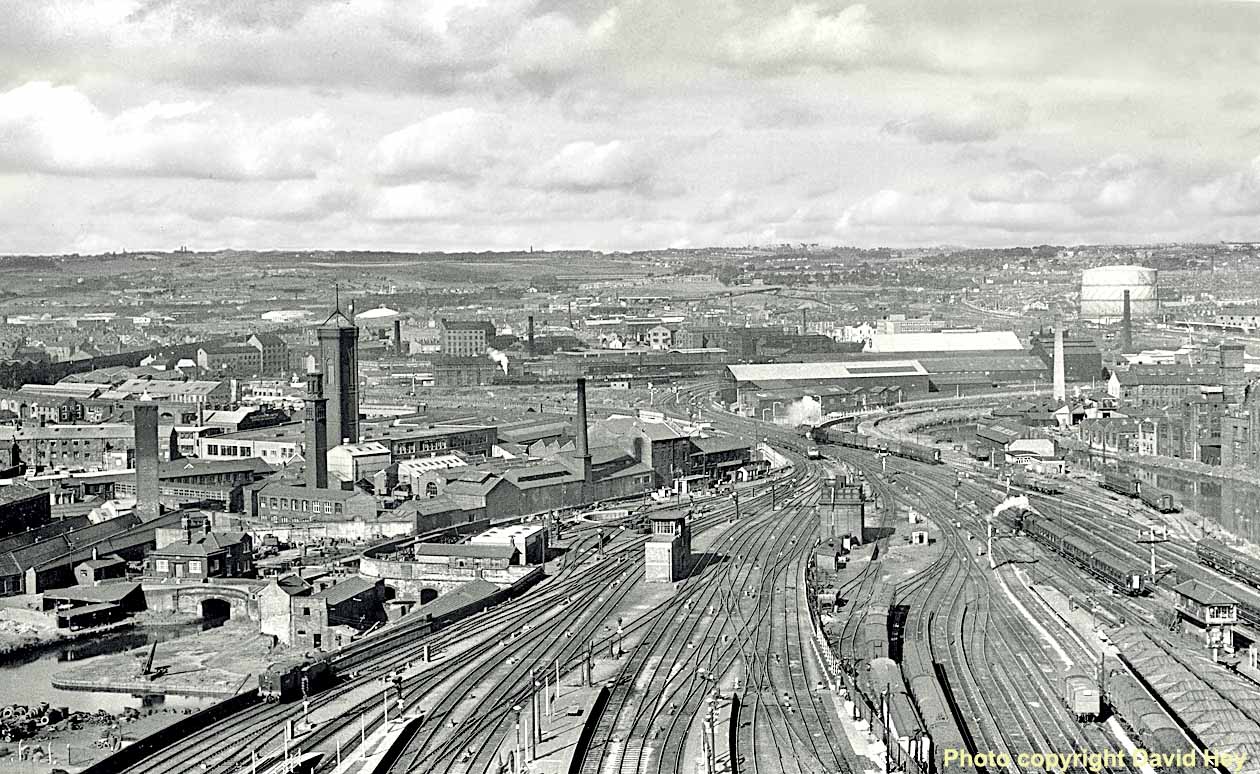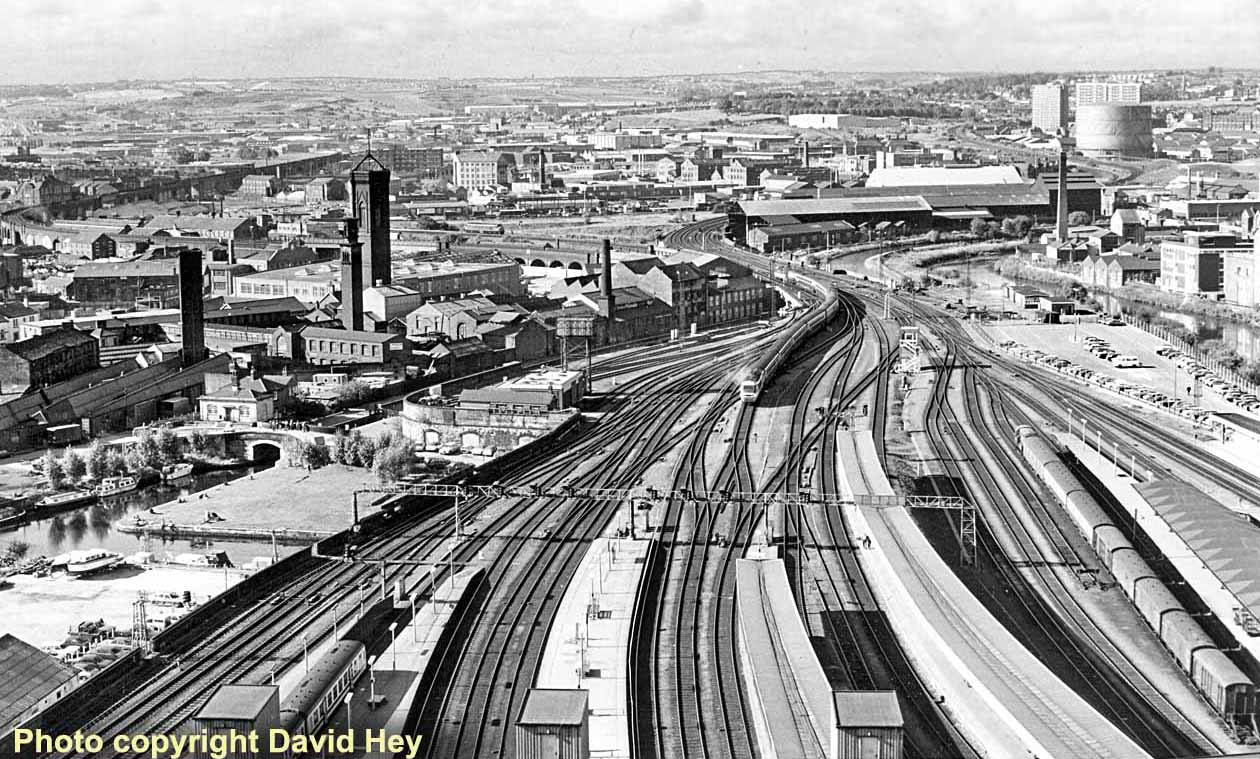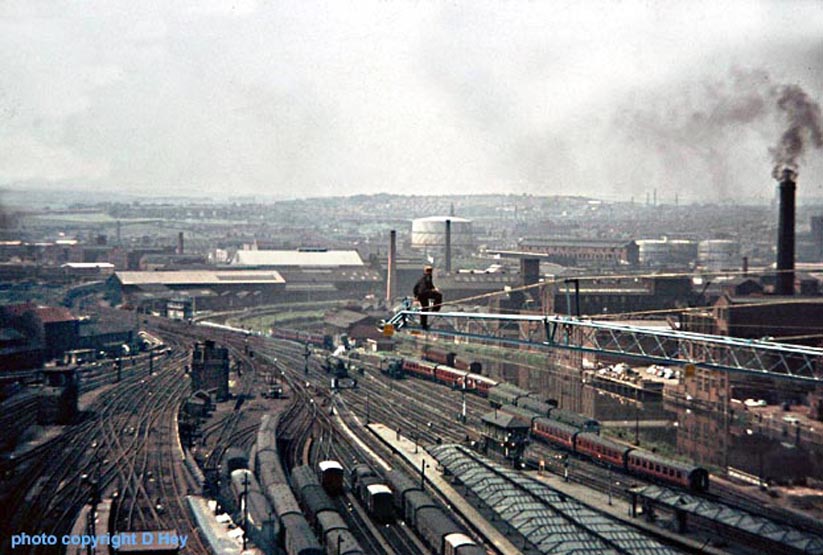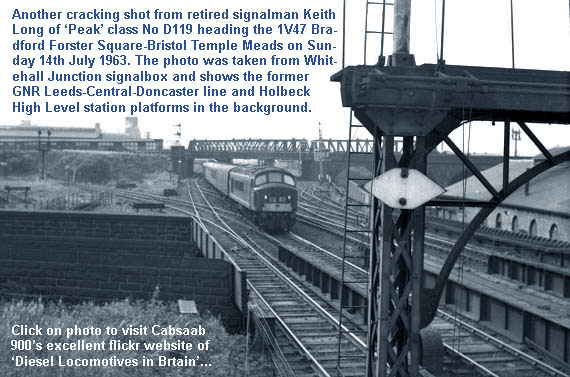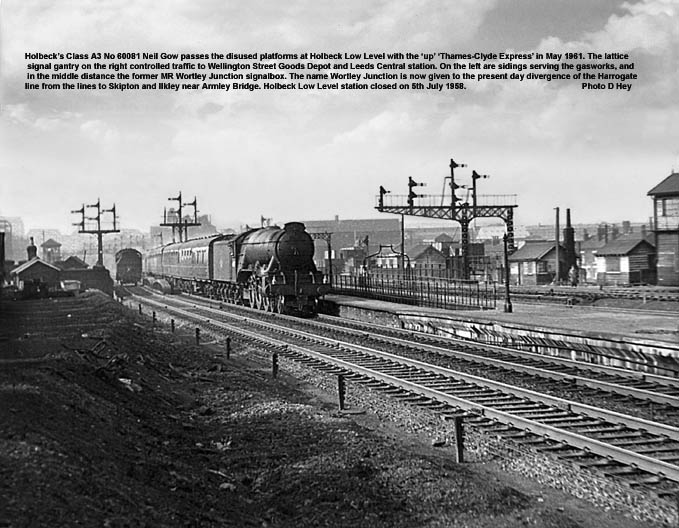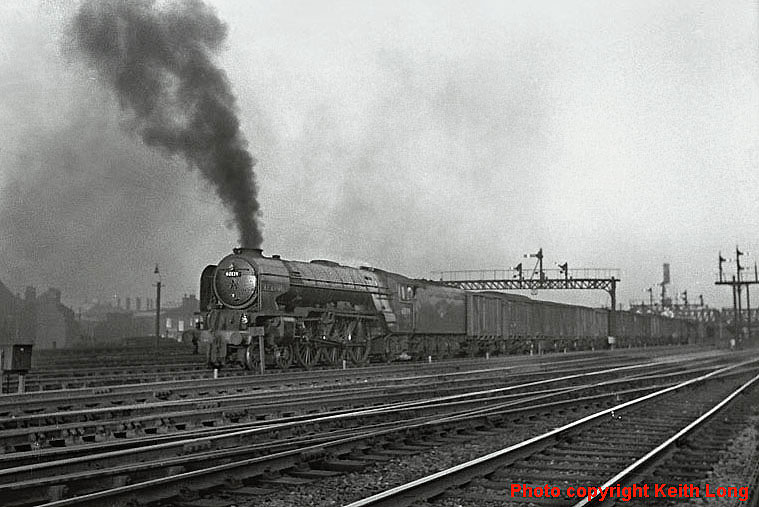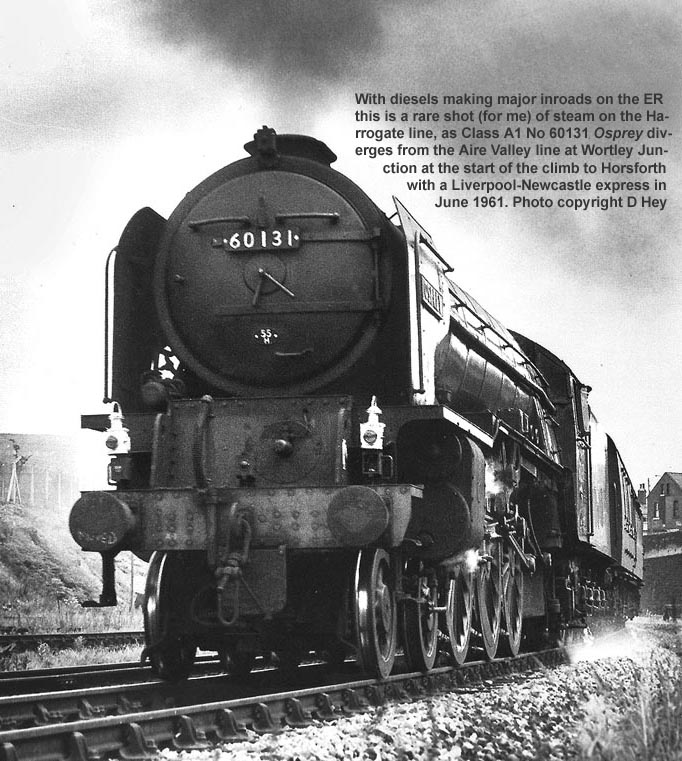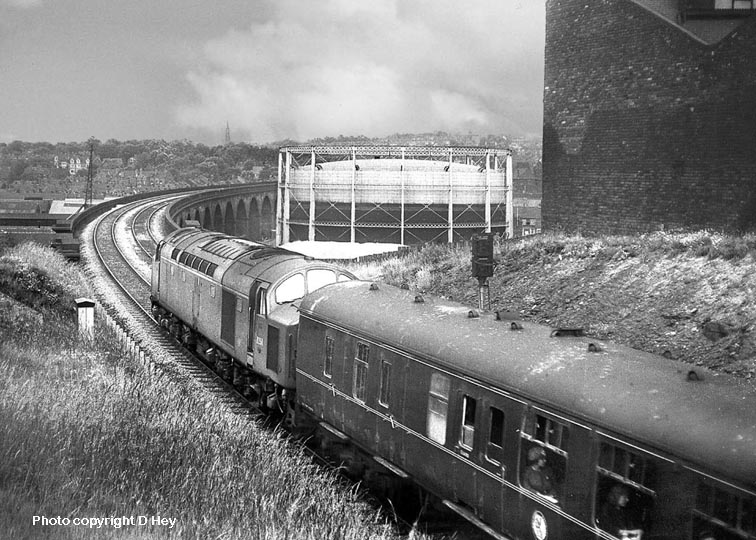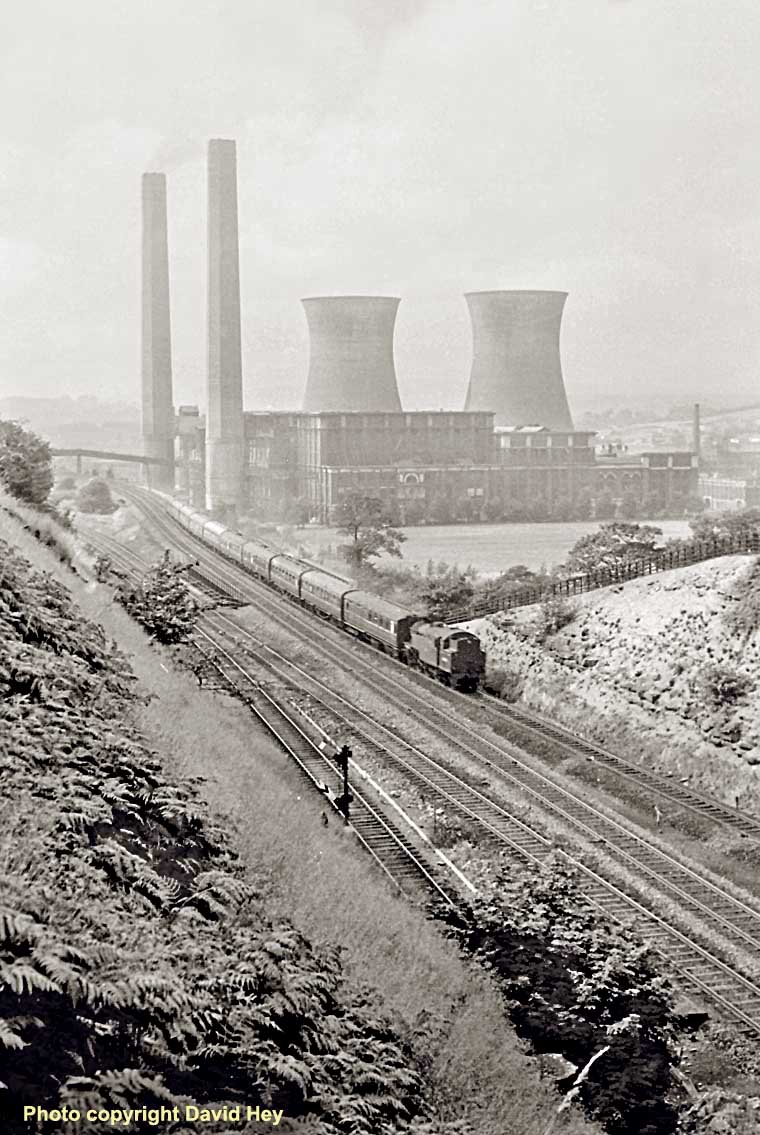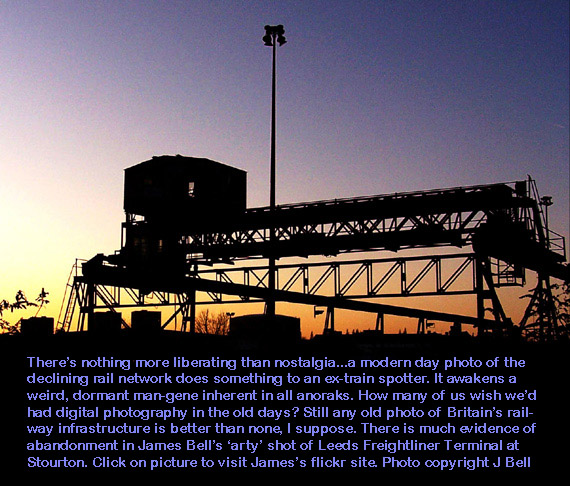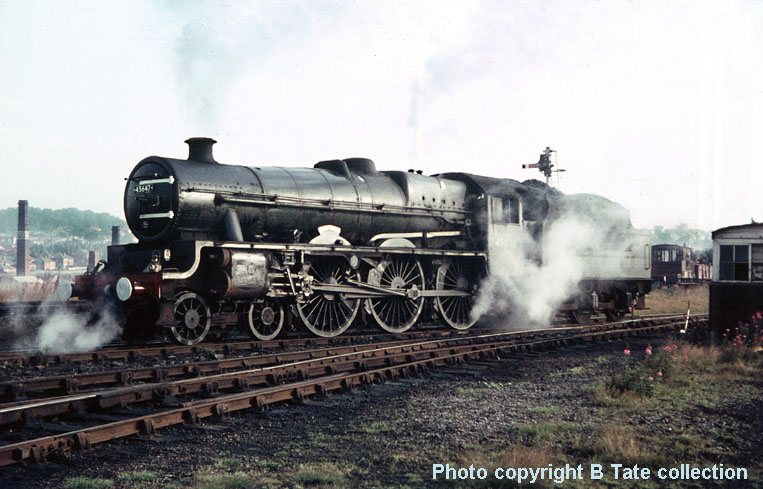(Above-Below) Returning to Leeds city centre again, the railway scene has radically changed over the years, particularly since the erection of steel masts and a curtain of overhead wires for the £306 million East Coast Main Line electrification scheme which connected the city with the main line at Doncaster in 1989. In the top (1960s) view, a Class V2 reverses past the signal box on its way to Neville Hill shed, whilst a Stanier tank fusses about with some parcel vans at the entrance to the former MR (Wellington) station on the right. In the distance a Metro-Cammel DMU heads past Leeds City East Junction, formerly Canal Junction, and next to the gas holders on the right (now the site of the present-day Armley gyratory road system) are the platforms of Holbeck High Level station on the GN line out of Leeds Central. The inner-city canal basin on the left has been completely transformed, whereas the dust extractor tower (a copy of the famous Giotto's campanile at Florence) remains a familiar landmark today. Comparisons can be made with the 1980s view below, which captures the exhaust of an 1C125 arriving from London Kings Cross.
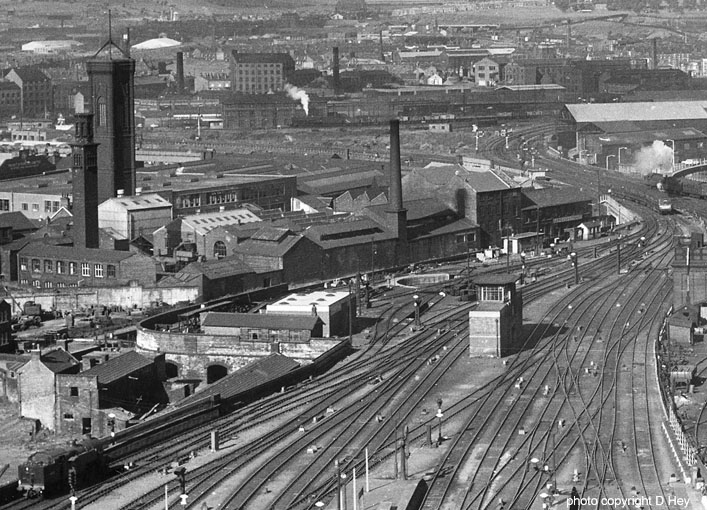
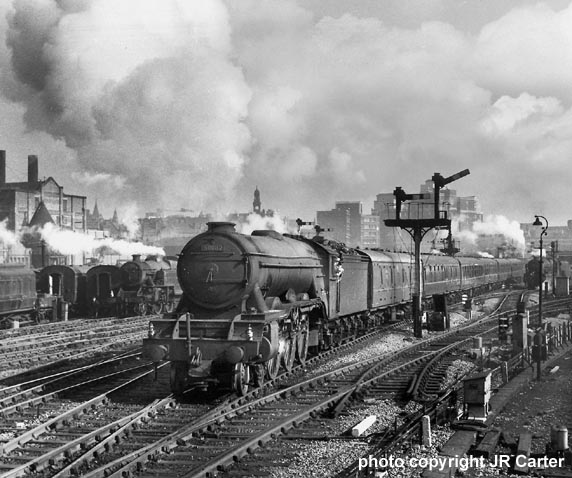
(Above-Below) The former MR Leeds Wellington station was essentially two halves, north and south, each with its own arrival and departure platforms used by trains from the south via Sheffield to St Pancras, and to the north via Shipley with connections to Bradford Forster Square, Ilkley and to Skipton and the S&C to Scotland. Class A3 No 60083 Neil Gow heads out of Wellington Street station with the 10am to Glasgow. The chimneys on the immediate left belong to the Leeds Corporation power station on Aire Street. (Below) Taken on the same day, 'Patriot' class No 45536 Private W Wood VC awaits the arrival of the 'Devonian' from Bradford Forster Square. Both photos JR Carter.
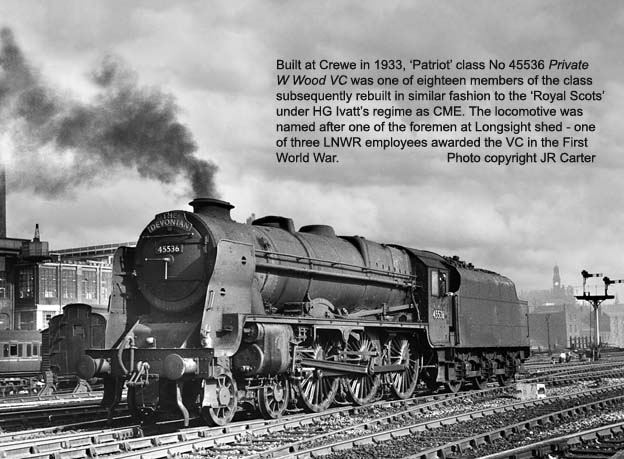

(Above) The Anglo-Scottish expresses on the former MR route from St Pancras to Glasgow had to reverse at the Leeds, including the 'Thames-Clyde Express'. Perhaps older enthusiasts will recall the summer timetables in the Fifties and Suixties when both 'up' and 'down' trains were booked to arrive at Leeds at the same time - approximately 14.30. However, because of the length of both trains, the island platform 5-6 had to be used, therefore passengers entering the station found themselves facing two identical expresses standing side-by-side, each carrying non-reversible 'London-Leeds-Glasgow' roof boards on the carriages, and as both the 'up' and 'down' trains arrived and departed in the same direction, the station staff had to make sure that no hapless passenger ended up travelling in the opposite direction they intended! It later transpired that Skipton became the passing point. Here, an unusual sight (in the final days of steam) a pair of Black 5's await departure from Wellington Street station in June 1966. The site was later developed as a parcels depot and car park. 

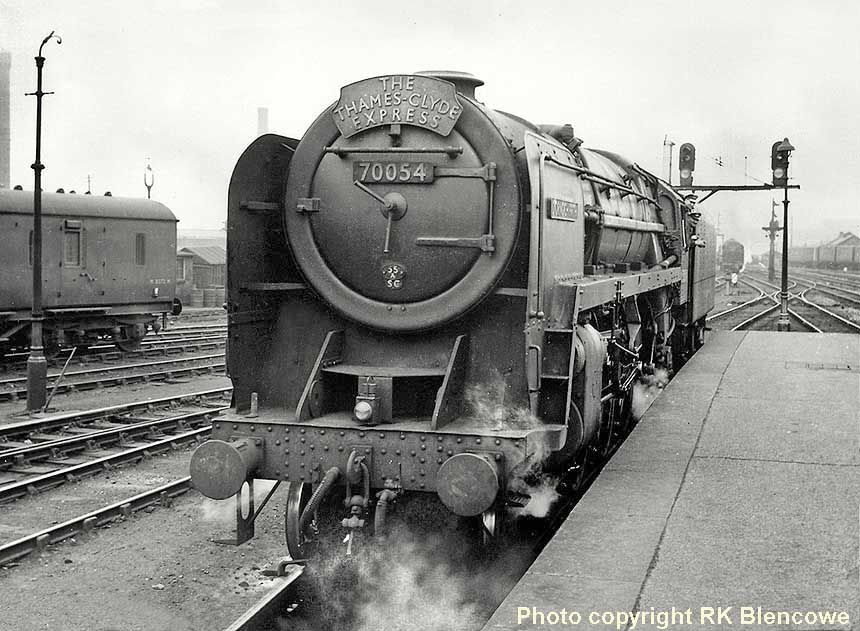
(Above-Below) Following arrival at Leeds Wellington station with the southbound 'Thames-Clyde Express' on 8th May 1959, the crew of 70054 Dornoch Firth await signals before backing out of the platform for Holbeck shed. 70054 was the last of the 'Britannias' to be built at Crewe in September 1954, just 3 months short of four years since the first, No 70000 'Britannia' was constructed, and costing rather more at £25,331. The Order No E486/234 was authorised on 24th November 1951, but construction was delayed due to steel shortages. 70054's first allotted shed was Glasgow Polmadie (66A) where it spent just over four years. 70054 then moved to Leeds Holbeck MPD (55A) at the start of November 1958, along with 70053 Moray Firth, spending 3 years and nine months there before moving to Crewe North MPD (5A) in August 1962. The last shed was Carlisle Kingmoor, where 70054 was withdrawn on 26th November 1966 and disposed of at Motherwell Machinery & Scrap Co's Inslow Works at Wishaw. Full details of all the 'Britannia' class locos can be found on Derek Dean's remarkable Page 91, which features a step-by-step history of each loco. 
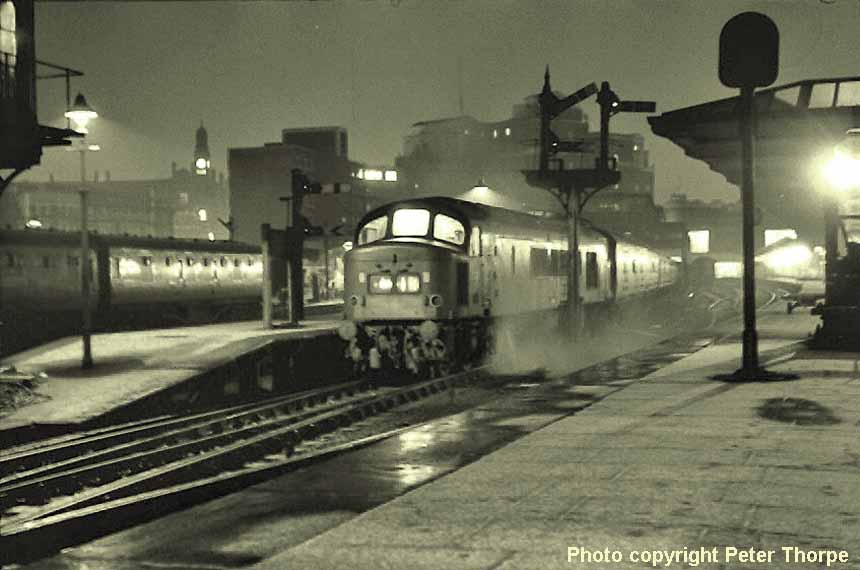
(Below) A locomotive nameplate 'Book Law' as carried by the LNER 4-6-2 Pacific A3 class loco 2599 built at Doncaster works in July 1930, was sold for £8,200 at a sheffield Railwayana Auction in March 2009. Renumbered 88 in August 1946 and then BR 60088 in July 1948, the loco is seen here at Holbeck Shed (55A) with its double chimney fitted in July 1959. Trough-style smoke deflectors were fitted in June 1961. A long-time Heaton engine, 60088 had a brief spell at Leeds (Neville Hill) before being withdrawn in October 1963 from Gateshead and cut up at Darlington in November 1963. The numbers '2599' and '88' are clearly stamped in the base of the cast brass plate. Book Law was named after the 1927 St Leger winner.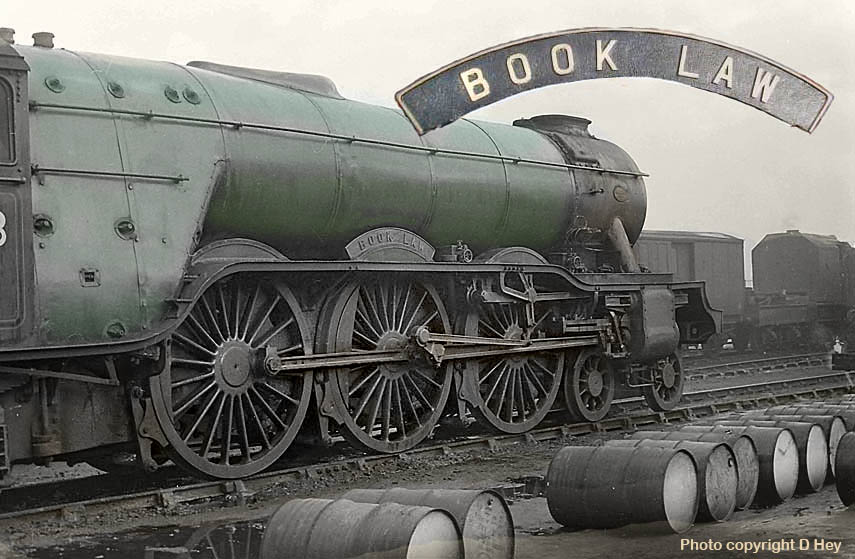
(Below) Having recently invested in a replacement slide scanner - the last one gasped its last breath and refused to give up the negative strip locked in its jaw! - it's now time to make a fresh start on resuscitating 50 year-old negatives which are like ghosts from the past and need to be exhumed (digitalized)...including this is one of an unidentified 'Jubilee' class heading south out of the city with the 'Waverley' express.
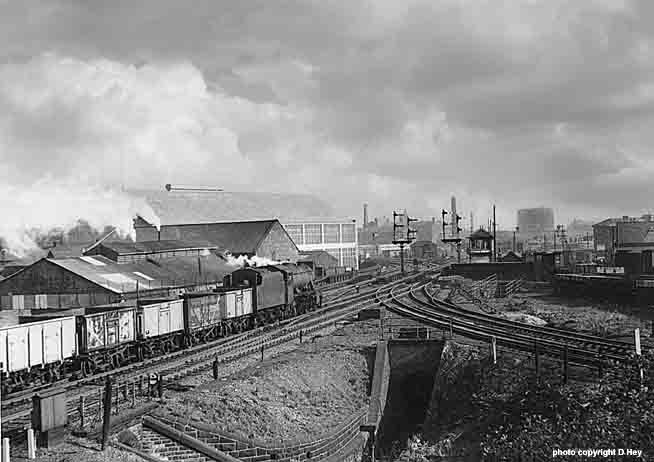
(Above-Below) A Class 8F heads a southbound empty mineral train towards Stourton in July 1962. The train will take the r/h spur (used by goods traffic to avoid Leeds City and Wellington stations) to Engine Shed Junction at Holbeck. The tracks bearing left form the ex-MR and NER lines from the north, which connected with the ex-MR line from Holbeck from the south at Leeds City North Junction. These were then joined by the ex-LNWR lines which crossed the viaduct from Farnley Junction to Canal Road Junction on the western approach to Leeds City and Wellington stations. The apex of the triangular junction (a recessed-wall area on the rail bridge above Globe Road) was a favourite place for observing trains, since you could see rail traffic coming and going in all directions!
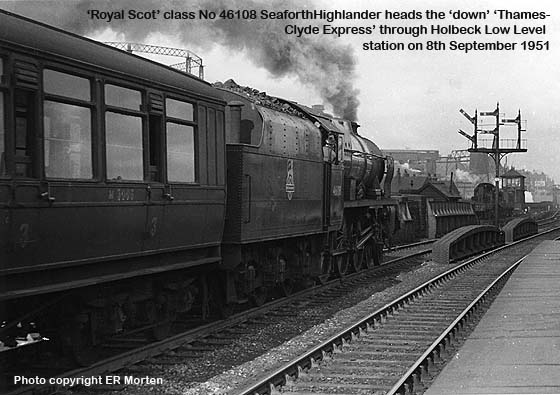
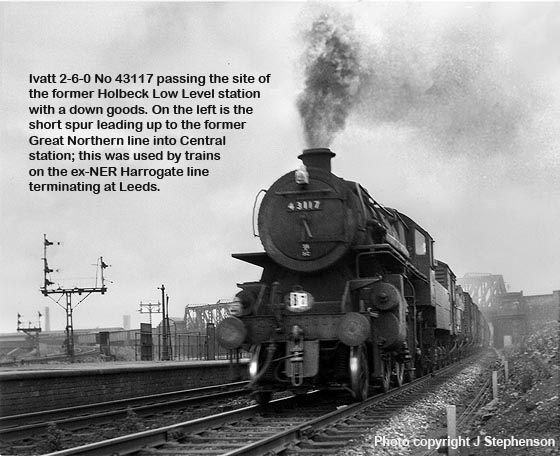
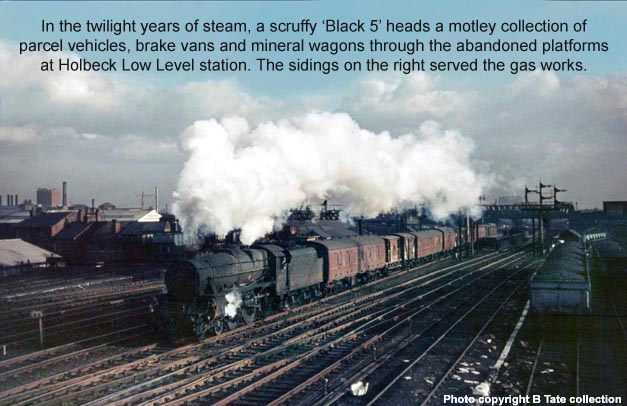
(Above) An interesting shot of Class A1 No 60139 Sea Eagle with the 19.30 Wellington Street to London Kings Cross express goods on 8th August 1962. Having drawn out of Wellington Street yard to Geldard Junction, the train now occupies the 'down main' with the assisting engine attached at the rear. It will cross to the 'up main' to go up the bank to Leeds Central 'B' Box. This movement is controlled by a main semaphore signal on the gantry at the rear of the train - the calling on signal you see is a repeater for this signal. The area was a complex one with signalboxes very close together; a similar move was made with trains from the Midland Lines (the four lines in the foreground) to Wellington Street Yard; they would cross onto the 'down main' at Wortley North Box about 200 yards to the left of the camera. Then they would propel into Wellington Street Yard's facing road in the 'up' direction over the 'down' through the block section between Wortley North and Geldard Junction. The only restriction was that during fog or falling snow an assisting engine was attached to draw the train into Wellington Yard. Photo and text information by Keith Long. Click on picture to visit Keith's 'Rail Cameraman Page'.
(Above) EE Co Type 4 No D250 gets to grips with a ruling gradient of 1 in 100 for the 5-mile climb from Wortley Junction to the summit just beyond Horsforth station. In the background, Burley Viaduct - a popular venue for photographers of today's 'Scarborough Spa Express' steam specials - carries the Leeds Harrogate line over the Leeds-Liverpool Canal and River Aire out of the city.
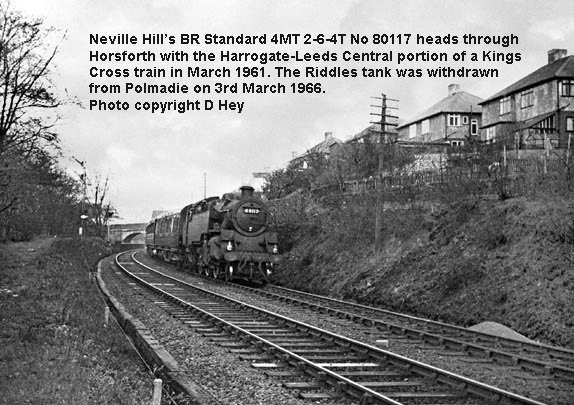
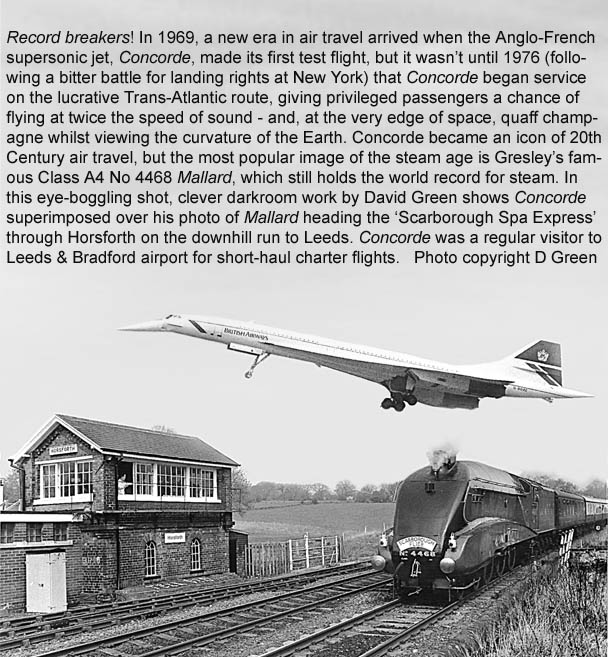
(Above-Below) At the turn of the century, the MR main line between Leeds and Shipley was increased to four tracks, and this involved the construction of a flyover junction at Kirkstall to segregate local Leeds-Bradford trains from through traffic to Scotland over the Settle-Carlisle line. The giant cooling towers and twin chimneys of Kirkstall Power Station dominate these views of Fairburn 2-6-4T working a Bradford Forster Square portion of a train from St Pancras. For operational reasons the NER adopted a policy of using tank engines on express workings between Leeds and Bradford to avoid the untidy operation of reversal. (Below) No 42189 is working bunker first with a train from Bradford Forster Square. Click link to visit three pages of the AireValley Line during the 1960s.
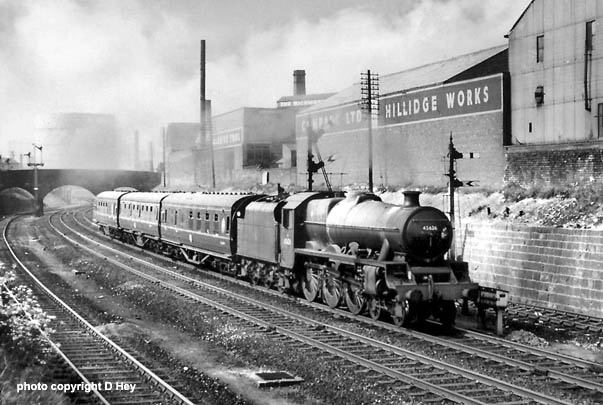
(Above-Below) Meanwhile, to the south of the city, mention of the transition from steam will always evoke strong emotions from a faithful band of enthusiasts, who remain unconvinced that steam had outlived its usefulness. At the time, BR was accused of placing too much emphasis on the procurement of diesels, and too little attention on providing adequate maintenance facilities, therefore it came as no surprise that a high incidence of diesel breakdowns occurred - and when it did, steam was usually called upon to save the day (a point immediately seized upon by the die-hards of the steam faith). Here, a dmu failure probably accounted for the appearance of 'Jubilee' class No 45626 Seychelles on a local Leeds to Sheffield train between Hunslet and Stourton in July 1963. (Below) 'Britannia' class 7MT provides adequate power for a lightweight southbound train.

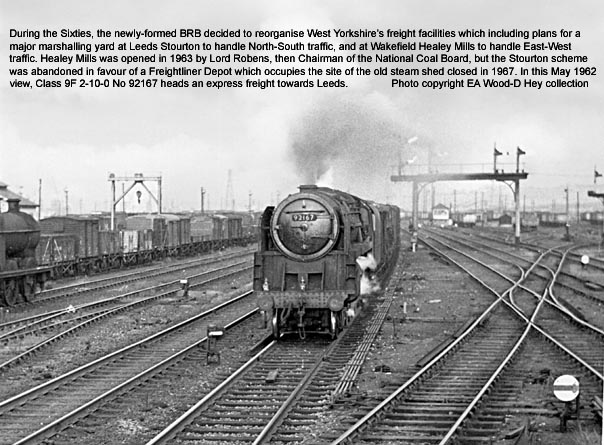
(Above-Below) Two views of Stourton on the MR route south of Leeds - a 1960s shot of a Class 9F heading a northbound freight and, at the same spot some twenty years later, a refurbished Metro-Cammell dmu - forming a Sheffield to Leeds service via Normanton - passing Wakefield Road signal box in October 1983. By this time, the first generation dmus (built to designs conceived during the 1950s) were more than a decade past their best, yet they continued to put in sterling service on the rail network. In 1975 BR introduced a refurbishing programme, including repainting, improved heating and ventilation, soundproofing and general improvements to the interior. The treatment may well have been tangible proof of the worthiness of the old stock, yet it served to underline the need for more modern vehicles. Of further interest for dmu fans is the aged BR Class 100 dmu Nos 51122 and 56300 parked in the left background. Built by Gloucester RCW, the units were retained for departmental use - dubbed the 'Stourton Saloon' - for use by the Eastern Region's Area Manager and line inspection up to withdrawal in 1990. In the right foreground, track realignment is underway serving the Freightliner Terminus at Stourton.
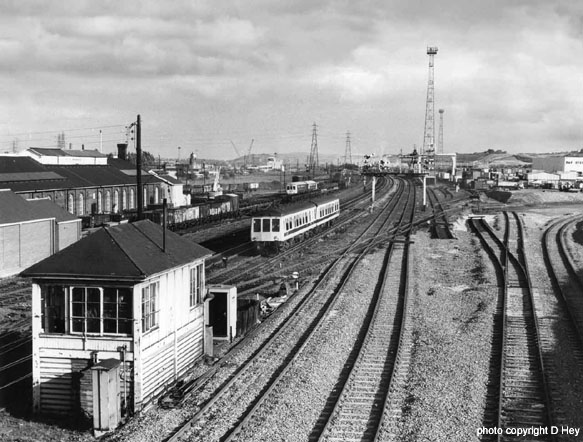
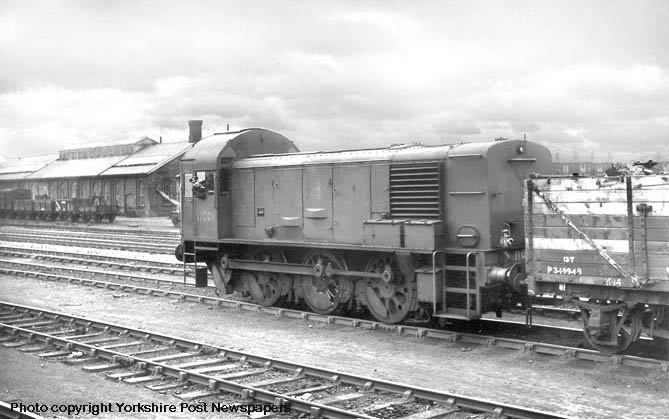
(Above) An interesting shot of the prototype SR/Paxman 500hp 0-6-0 diesel-mechanical shunter No 11001 sorting out some wagons at Stourton on 31st July 1952. Designed by Bulleid, the shunter was introduced in 1950 for shunting purposes and branch line workings, but the gear ratio was found to be unsuitable for either purpose and the locomotive was the sole example built. It spent much of its life based at Norwood Junction and Redhill depots on the Southern Region, except for a period undergoing trials at Leeds. Photo copyright Yorkshire Post Newspapers.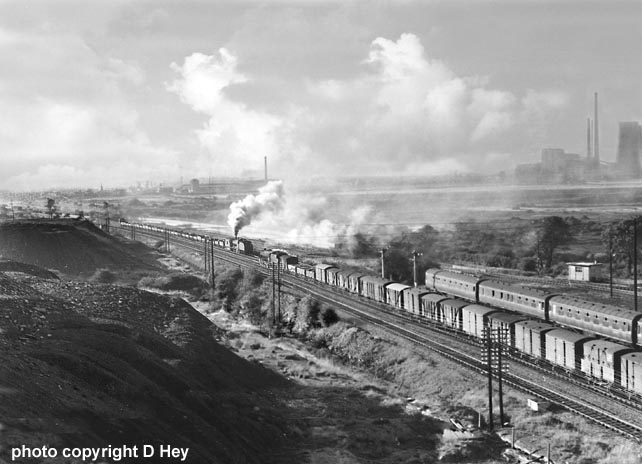
(Above-Below) Photographs of steam in the landscape are hardly remarkable since an engine trailing smoke and steam was an everyday occurrence in the early 1960s, yet it always turned people's heads. Here, a Class 4F and Black 5 pass on the former MR main line at Woodlesford, south of Leeds. In 2005 I tried to trace the exact spot of this shot, but the foreground is now shrouded in tress and shrubs, the Skelton Grange Power 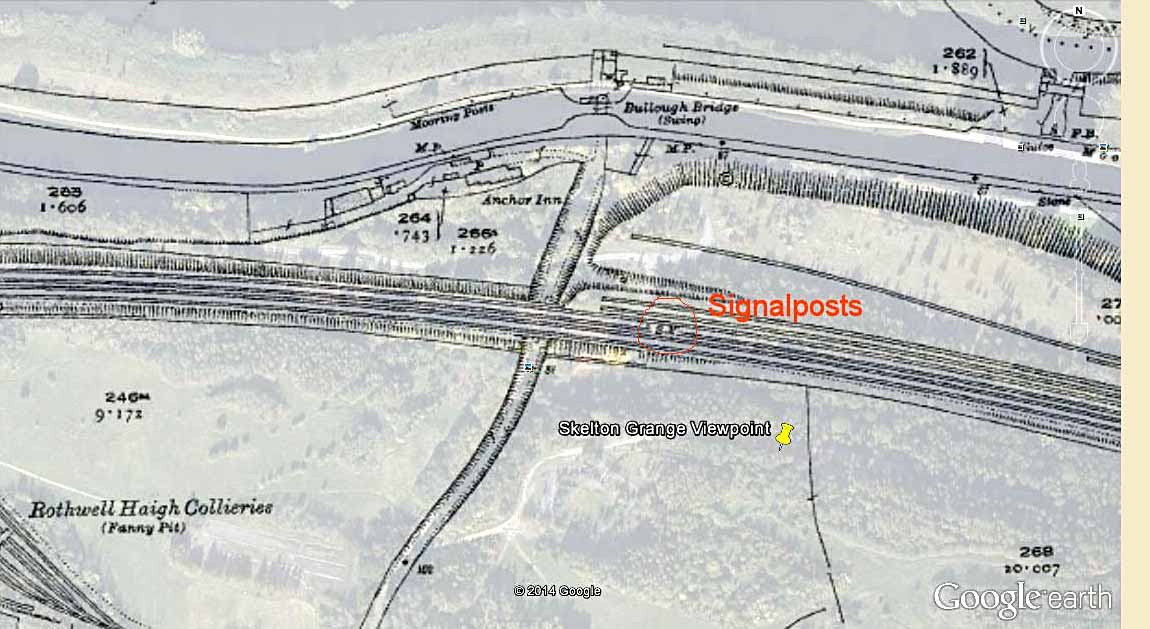 Station has long since gone and the motorway extension connecting the M1 with the A1(M) at Wetherby crosses the line hereabouts, so my search was fruitless.
Station has long since gone and the motorway extension connecting the M1 with the A1(M) at Wetherby crosses the line hereabouts, so my search was fruitless.
MYSTERY SOLVED! I've recently been contacted by rail enthusiast Keith Rigby, who has spent the past few years recreating the Aire Valley Line using Microsoft's Train Simulator. Keith has kindly provided several 'still' images from his model for me to look at, and at some time in the future I'm hoping to use some of Keith's images on the recently revamped Aire Valley Pages 49-51 - see left-hand menu.
Meanwhile, when Keith was researching the Aire Valley Line he often browsed this website to work out the exact locations of the photos, the positions of various trackside paraphernalia and the viewpoints from where the shots were taken in order to get the accuracy he wanted; indeed this method of research has become almost second nature to him. 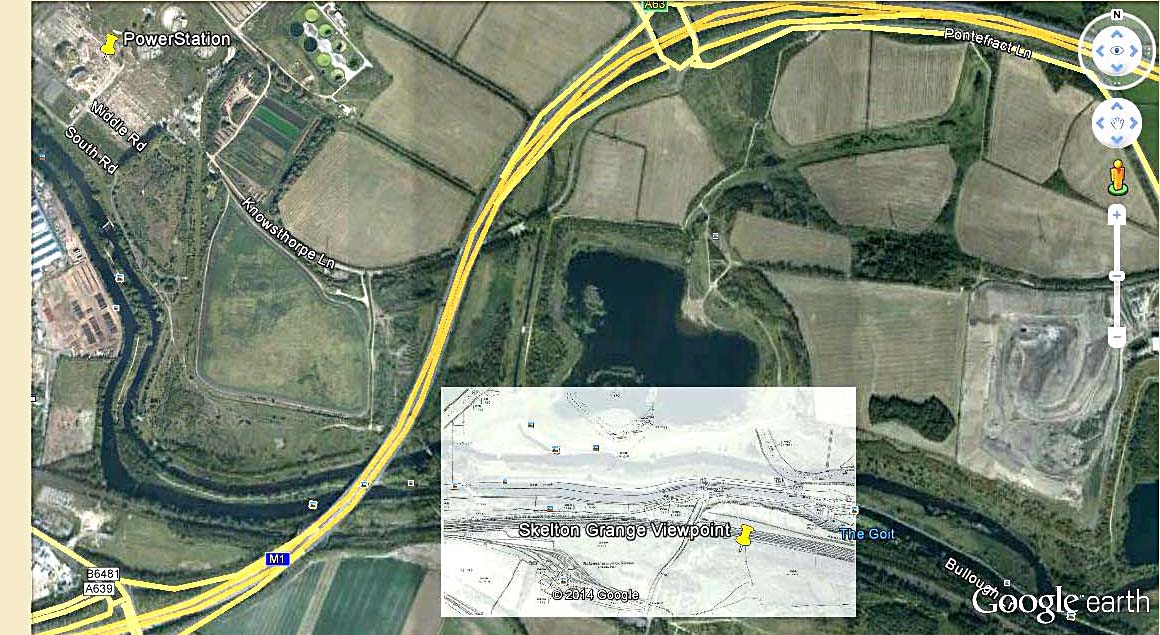 He writes - 'Hi David, I noticed you'd been trying to figure out where the shot of the line near Woodlesford was taken, and since the power station went years ago, it's a bit difficult, so I had a go at your photo and overlaid an old 1920's 1:2500 OS map on Google Earth at the approximate location until I had everything just about lined up. The carriage sidings and canal lock gave the location away, whilst the signals, bridge under the railway, the 65yd telegraph pole spacing and angle of the shot gives the exact spot as N53.764256, W1.467866.
He writes - 'Hi David, I noticed you'd been trying to figure out where the shot of the line near Woodlesford was taken, and since the power station went years ago, it's a bit difficult, so I had a go at your photo and overlaid an old 1920's 1:2500 OS map on Google Earth at the approximate location until I had everything just about lined up. The carriage sidings and canal lock gave the location away, whilst the signals, bridge under the railway, the 65yd telegraph pole spacing and angle of the shot gives the exact spot as N53.764256, W1.467866.
As you say in your caption the area is overgrown now, so you'd need a pretty tall pair of steps to get the same shot today! However, in Google's 2002 aerial view, the bases of Skelton Grange's cooling towers are clearly visible and these can be seen at the extreme right of your photograph. Regards, Keith.'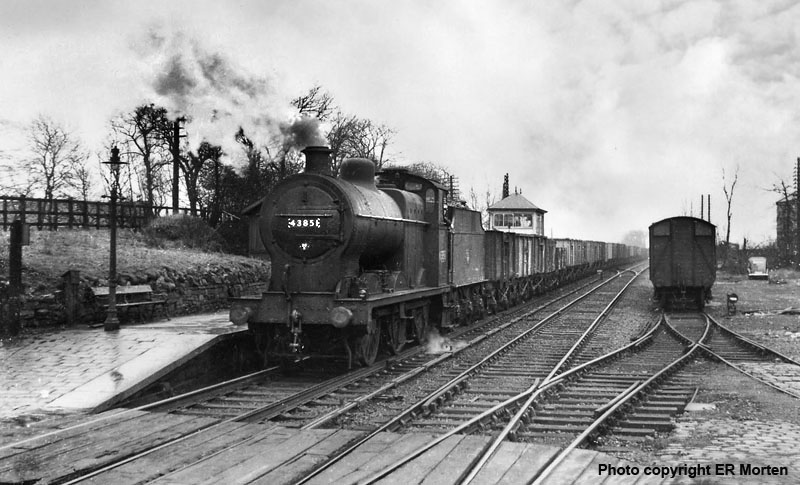
(Above) ER Morten's shot of Woodlesford station shows one of Stourton shed's Class 4Fs, No 43851, propelling wagons along the 'up' line from Waterloo towards Methley on 9th April 1955. My thanks to Howard Benson, who has designed and developed the excellent 'Woodlesford Station' website link here, for his comment - 'The wagons may be going to Methley Saville or to Water Haigh in which case the driver would have stopped after the crossover and then drawn onto the 'down' line before reversing again into the Water Haigh siding. It was also the practice to work wrong line on the 'down' from Waterloo direct into the Water Haigh branch, which is how the Woodlesford station porter, Harold Ellis, lost his leg - he was walking in the four foot in the fog along the 'down' towards Methley (correctly) but he didn't realise an engine and brake were behind him until too late...'
(Above) Built at Crewe in January 1935, 'Jubilee' class 4-6-0 No 45647 Sturdee had a number of shed allocations throughout its career, including Crewe North, Bushbury and Aston shed. During its final seven years in service, the loco was transferred to Saltley in March 1963, then to Farnley Junction in August where it spent three years before moving to Holbeck in November 1966. (Above) No 45647 is immaculately turned out with white painted buffer heads, smokebox door hinges - even the lamp brackets have been picked out with a lick of paint! Perhaps it might not be everyone's cup of tea, but at least it showed someone cared during its final years. The loco was photographed at Farnley Junction prior to working a Leeds City-Blackpool North excursion on 23rd October 1966, though this date is now subject to scrutiny - see email below...![]() ...I am regularly contacted by railway historian, Vic Smith, who is currently working on 45647's movements between July and November 1966.
...I am regularly contacted by railway historian, Vic Smith, who is currently working on 45647's movements between July and November 1966.
He writes - 'Hi David, there are numerous published images of 45647 working Leeds-Llandudno and Leeds-Blackpool trains between July and November 1966. However, the accuracy of the dates cannot be trusted, as the loco had several distinctive 'paint liveries' during that time, proving that several of the dates quoted for the published photos are incorrect.
From my research so far, the following paint jobs were recorded in 1966...
July 2 - 09.08 Leeds/Bradford - Poole. Filthy condition.
August 6 - Leeds-Llandudno. Engine now cleaned, tender dirty, No white paintwork.
August 20 - Leeds-Llandudno. Smokebox door handrail mounting brackets only, door straps, smokebox lamp bracket, buffers, drawbar and shedplate painted white.
August 29 13.15 Llandudno-Manchester Exchange. Smokebox door handrail complete, door straps & hinges, ends of smokebox door handles & bulls eye, buffers, smokebox lamp bracket, drawbar, sloping front framework & handpainted shedcode all painted white.
Oct 21 Leeds City-Blackpool North. Smokebox door straps & buffers only painted white. Number plate rivets now black.
This brings into doubt the dates for the images above and below. The image (above) is incorrect for 23 October 1966, as three other images for that date show the smoke box door handles at 7.25 position and no white paint on smokebox door handrail brackets, number plate rivets or drawbar.
The second image (below) dated 23 October 1966 working the 1X10 Leeds-Blackpool, is I believe, also incorrect since 1X10 was the Friday Only, Illumination Special from Leeds to Blackpool, returning on Sunday, running from 2 September to October 23.
45647 worked this train on three occasions, Sept 2, October 7 and 21. 45562 worked all the remaining dates.
This must be Sept 2 or Oct 7, as by Oct 21 it had different paintwork.  It would be nice to know when these paint changes occurred. Any further help from your viewers would be appreciated.
It would be nice to know when these paint changes occurred. Any further help from your viewers would be appreciated.
Best wishes, Vic Smith. York...'
If anyone can help Vic's research, his email address is:
trainman39@sky.com
Please note this is not a 'clickable' email link via Outlook Express.
You will have to email manually.
Many thanks...
(Below) 45647 is seen passing Farnley Junction shed. The loco was withdrawn in April 1967 and stored at Wakefield before being cut up at Cashmores, Great Bridge in September 1967 (Inset) A shedplate, 55C Farnley Junction (used from October 1956 to November 1966). This ex-LNWR shed was transferred from the London Midland Region (25G) in 1956, when all 50 locos received this code. In its final year it had just 5 Black 5s, a solitary 8F and 3 Jubilees


(Below) The Swindon-built Trans-Pennine (TOPS Class 124) units were a stylish addition to the BR fleet, providing 6 trains each way daily on the Liverpool-Hull service via Standedge. With their 228 tons tare load, the seventeen 6-car sets (including a griddle car) necessitated a formidable 1,840 horse power for the steeply-graded route across the Pennines.The power/weight ratio made possible substantial acceleration of the service, and a total running time of 163 minutes was introduced on the 128 mile route between Hull and Liverpool. A distinctive feature of the Class 124's was the use of a glass-reinforced plastic for the wrapped round windows on their driving car ends. The service began on January 2nd 1961 between Hull, Leeds, Manchester and Liverpool. Here, a Hull-bound set approaches Farnley (the shed roof can be seen in the background) in June 1961. The present-day Leeds-Manchester line runs through the cutting in the middle-distance.
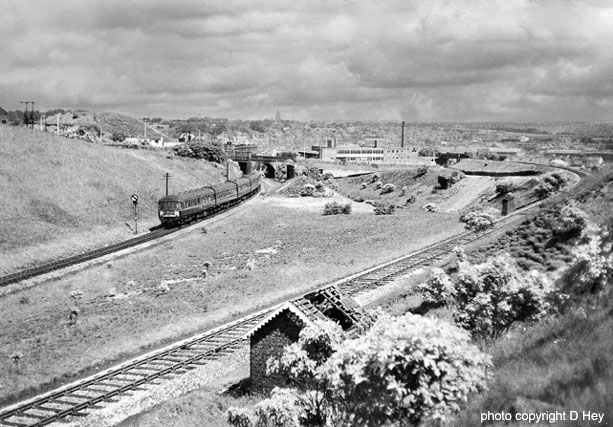
Polite notice: All text and photographs are protected by copyright and reproduction is prohibited without the prior consent of the © owners. If you wish to discuss using the contents of this page the email address is below. Please note - this is not a 'clickable mail-to link via Outlook Express:
dheycollection@ntlworld.com

